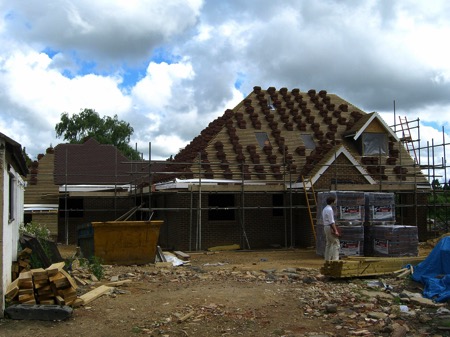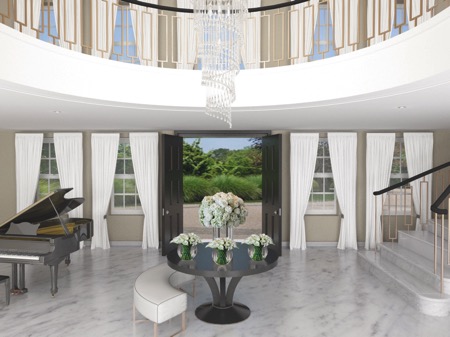October 2015
Dangerous pitfalls and heavy costs when extending or refurbing
28/10/15 19:07 Filed in: Property

As housing sales drop 13% and people stay put, tips on avoiding dangerous pitfalls and heavy costs when extending or refurbing.
By David Lewis, partner at Grillo LLP Chartered Surveyors, Surrey.
The latest Land Registry figures show that the number of house sales in England and Wales for June dropped by 13% since June 2014.
By contrast, the number of residential planning applications rose by 10% between April and June this year, according to the Department for Communities and Local Government.
This suggests the property market is stuttering as people are concerned about Stamp Duty and the cost of moving. And with planning relaxed, they are opting to stay put and make changes to their existing home.
But with increased demand for builders to extend and refurb, and the shortage of builders, costs are rising and it is vital to have someone monitoring them. Grillo LLP Chartered Surveyors are very experienced designers and project managers and recommend the following steps to avoid heavy costs.
1. Before you start, thoroughly consider what you are trying to achieve. Take advice from a reputable professional firm as an objective view from a third party can be helpful.
2. Make sure that before you appoint them, your designer has an intimate knowledge of building design and techniques. This is especially important when dealing with the details and materials in buildings of different periods and areas in West Surrey, West Sussex and East Hampshire.
3. It is also essential when designing alterations for Listed Buildings to get the Conservation Officer to agree. So, find a firm of professionals who know the historic details of period properties and therefore can have a useful discussion with the Conservation Officer.
4. Ensure that your designer has a comprehensive working knowledge of the Building Regulations, so that your plans comply. Without such knowledge, he or she will cost you unnecessary time and money having non-compliant details changed.
5. Be aware of physical constraints of the site. There may be a watercourse and high water table or a steep-sided bank or retaining wall, which can affect the potential use of the building and the construction work. If your designer doesn’t take these into account in the initial site appraisal, the cost of having to undertake expensive additional work might come as a nasty surprise later in the project.
6. Avoid disputes over the quality and the extent of work included in the contract price, by insisting on a comprehensive specification being prepared, based on Building Regulations and the approved design.
7. Make sure you get a professional like a Chartered Surveyor, project manager or architect to both design and oversee the building work. This will prevent disputes with builders over standards and the quality of work. Such disputes can lead to work remaining unfinished while legal matters are pursued, or after the work is finished, disagreement continuing over payment.
“Whilst carrying out Surveys of Condition for prospective purchasers, we sometimes discover that an extension was built or an alteration had been made without Building Regulation Consent,” says David Lewis, partner at Grillo LLP. “A frantic scramble can ensue whilst the vendor obtains the Completion Certificate.
“Lastly, a complete set of paperwork with all the Consents and Certificates means that any sale of the property will go ahead quickly without the extra cost of a lawyer’s time chasing around for the information, or, alternatively, without the cost of insurers providing an Indemnity Policy where the paperwork is not in place.”
Grillo LLP Chartered Surveyors
Telephone: 01483 860600
Website: www.grillollp.com
Making and entrance

Entrance halls offer the chance to make a statement, to set the scene for the rest of the home. Jenny Allan from JCA Interiors explains how to make sure this area gives that great first impression.
When designing a whole house the entrance hall is always the first place to start as it is the central pivotal point of the home and sets the scene for the rest of the design.
The style must be cohesive with other principal rooms which lead from the hall as there will be internal vistas through to those rooms when doors are open.
An essential part of creating a stunning entrance area is an impressive front door and it should look good from the inside as much as outside. It must be in proportion and complement the architecture of the property whilst being inline stylistically with the rest of the interior.
A further essential consideration, at the central core of the property, is the staircase which has the ability to be an incredible design feature. A multitude of choices are available in all different finishes: from floating wooden treads to marble helical staircases, there is an opportunity to create a real statement feature that will be the focal point of the house.
Good lighting is also critical in the successful design of an entrance hall. A chandelier or modern piece of designer lighting creates impact and can make a powerful first impression. The proportions of double height entrance halls should be enhanced by this feature light which encourages the eye to be drawn upward, emphasising the height and space on show. Further wall lights or downlighters can be incorporated to balance the powerful centrepiece ensuring all areas have adequate light.
Creating a flow through the house is an important part of an effective design. This should be felt from the moment the front door is opened and furniture selection in an entrance hall is a key part of this. Mirror the shape of the hall with a console or central table which is attractive, but easy to walk around. If the hallway is a large area, it is important for the space not to feel empty and sparse, so ensure there is enough furniture and features to make it feel homely. In some cases it may be appropriate to add a seating area or even a grand piano to complete the design.
The entrance hall can be an ideal place for prized pieces of artwork or sculpture as there will be enough space around them so they are displayed and shown in their best light. Adding these pieces will offer the perfect finishing touches to an area of the house which has the potential to ‘wow’ visitors and create a stunning first impression.
Elegant, characterful or imposing, perhaps a mixture of the three, there is a myriad of options for creating a successful entrance hall, but just ensure it relates in a holistic way to the interior design of the rest of the house.
JCA Interiors
Jenny Allan is founder of interior design company JCA Interiors
Telephone: 020 3714 9325
Email: info@jcainteriors.co.uk
Website: www.jcainteriors.co.uk